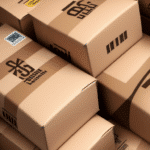How to Use Product Tags to Improve Your Business's Productivity
In today's fast-paced business environment, increasing productivity is essential to thrive and stay ahead of the competition. One of the most effective ways to achieve this is by using product tags. Product tags are small pieces of metadata that label your products with specific attributes, allowing for easy categorization, searching, and filtering. In this article, we will explore the many benefits of product tagging and how to use it to improve your business's productivity.
Understanding the Importance of Product Tags in Business
Product tags allow businesses to organize and categorize their products in a way that makes sense for their customers and their business needs. By assigning tags to your products, you make them easier to find and sort through, leading to increased productivity for both your employees and customers. Without product tags, your products may get lost in a sea of options, making it difficult for customers to find what they're looking for and causing frustration and lost sales.
Additionally, product tags can also help with search engine optimization (SEO) for your online store. By using relevant keywords in your product tags, you can improve your website's visibility in search engine results pages, making it easier for potential customers to find your products. According to a HubSpot study, businesses with effective SEO strategies see up to a 14.6% conversion rate, significantly higher than other marketing approaches.
The Benefits of Tagging Your Products for Increased Productivity
Using product tags comes with many benefits that can lead to increased productivity for your business:
- Efficient Inventory Management: Product tags make it easy to sort through your inventory and quickly find the products you need, saving time and effort for your employees.
- Enhanced Customer Experience: Customers can easily find the products they are looking for, leading to fewer questions and a smoother shopping experience.
- Data-Driven Insights: Product tagging allows you to track sales data and analyze patterns, providing valuable insights into your business's performance and helping you make informed decisions about inventory management and marketing strategies.
- Improved SEO: Utilizing relevant and specific tags increases the chances of your website appearing in search results, leading to more website traffic and potential sales.
Creating Effective Product Tags for Your Business
Creating effective product tags requires careful planning and consideration of what attributes are most important for your customers to know about your products. Here are some steps to create effective product tags:
Identify Key Attributes
Consider attributes such as size, color, style, material, or any other relevant feature that your customers value.
Use Consistent and Descriptive Language
Ensure that your tags are consistent and concise, using clear and descriptive language. Tools like keyword research can help you identify terms that resonate with your target audience.
Regularly Review and Update Tags
As your business and products evolve, so should your tags. Regularly review and update your product tags to align with industry trends and customer feedback.
Organizing Your Products with Tagging to Enhance Productivity
Once you've created your product tags, organizing your products using these tags is essential for enhancing productivity:
Implement a Tagging System
Create a system for tagging each product with appropriate attributes, making it intuitive and easy for both employees and customers to navigate.
Maintain Consistency
Ensure all employees are trained on how to use the tags correctly and consistently to maintain the effectiveness of the tagging system.
Facilitate Inventory Management
By tagging products with attributes like size, color, and material, you can easily track inventory levels and make informed decisions about restocking and ordering new products. According to a Harvard Business Review article, effective inventory management can reduce costs by up to 20%.
Using Product Tags to Analyze Sales Data and Improve Performance
Product tags provide valuable insights into your business's performance by allowing you to track and analyze sales data:
Identify Sales Trends
By analyzing sales data associated with different tags, you can identify which products or categories are performing well and which are underperforming.
Optimize Product Offerings
Use the insights gained from product tags to optimize your product offerings, ensuring you stock products that meet customer demand.
Enhance Marketing Strategies
Data from product tagging can inform your marketing strategies, helping you target promotions and campaigns more effectively. For instance, understanding which tags are most frequently used can help tailor your advertising to highlight popular attributes.
Integrating Product Tagging into Your Marketing Strategy for Better Results
Product tagging can play a crucial role in your marketing strategy by enhancing your SEO efforts and enabling targeted promotions:
Improve SEO
Using relevant and specific product tags increases your website's visibility in search engine results, making it easier for potential customers to find your products.
Enable Targeted Promotions
Leverage product tags to create targeted promotions and campaigns that resonate with customer preferences and behaviors, leading to higher engagement and conversion rates.
Best Practices for Maintaining Consistency in Your Product Tagging
Maintaining consistency in product tagging is vital for the system's effectiveness and overall productivity:
Create a Standardized Tagging Protocol
Develop a standardized set of tags and procedures for applying them to ensure uniformity across your product catalog.
Train Employees
Ensure all employees are trained on the tagging protocol to maintain consistency in how tags are applied.
Regularly Audit Your Tags
Conduct regular audits of your product tags to ensure they remain relevant and continue to effectively categorize your products. Updating tags in response to changing market conditions and customer needs is also essential.
Utilizing Automated Tools to Streamline Your Product Tagging Process
Automated tools can significantly streamline the product tagging process, especially for businesses with large inventories:
Implement AI and Machine Learning Tools
Tools that leverage artificial intelligence and machine learning can automatically identify and assign relevant tags to your products, reducing manual effort and minimizing errors.
Ensure Consistent Tagging
Automated tools help maintain consistency in tagging, ensuring that all products are categorized uniformly, which enhances searchability and organization.
Save Time and Resources
By automating the tagging process, businesses can save time and allocate resources more effectively, focusing on other critical aspects of operations.
Measuring the Success of Your Product Tagging Efforts and Making Adjustments
To optimize your product tagging system, it's essential to measure its success and make necessary adjustments:
Track Key Metrics
Monitor metrics such as website traffic, conversion rates, and sales data to assess the impact of product tagging on your business's productivity and performance.
Collect Customer Feedback
Gather feedback from customers to understand how product tagging affects their shopping experience and make adjustments based on their insights.
Continuously Improve Your Tagging System
Use the data collected to refine your tagging strategy, ensuring it continues to meet your business objectives and adapts to any changes in the market or customer behavior.
In conclusion, product tagging is a powerful tool for businesses looking to increase productivity and streamline operations. By using effective product tags, you can organize and categorize your inventory, track sales data, and improve customer experiences. Implement the tips and strategies outlined in this article to create an effective product tagging system for your business and start reaping the benefits of increased productivity today.




















